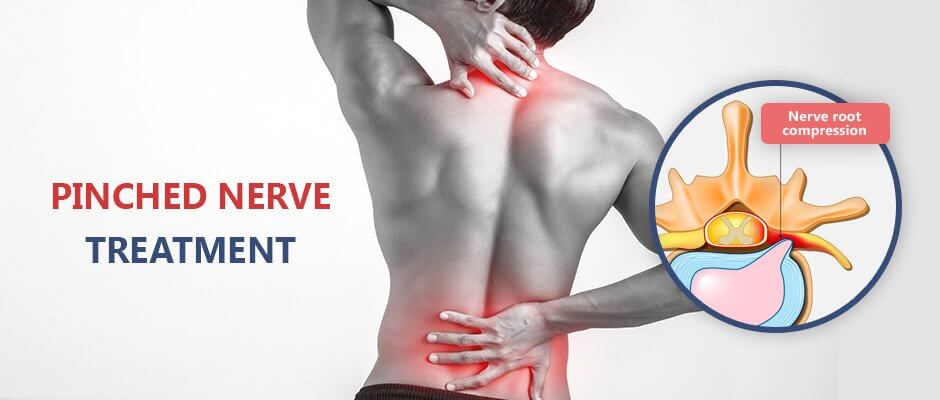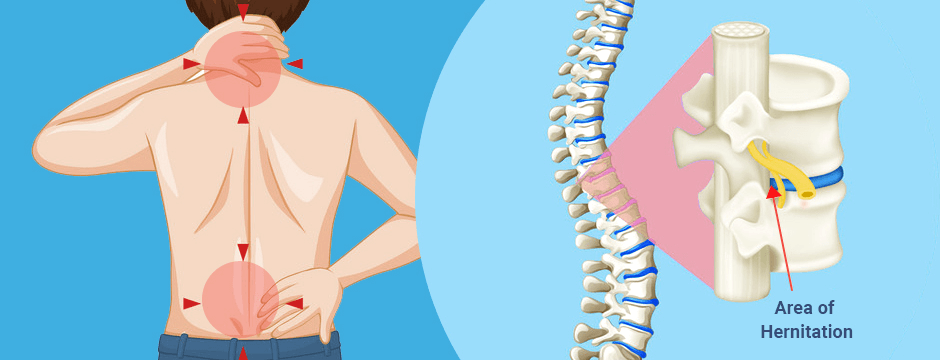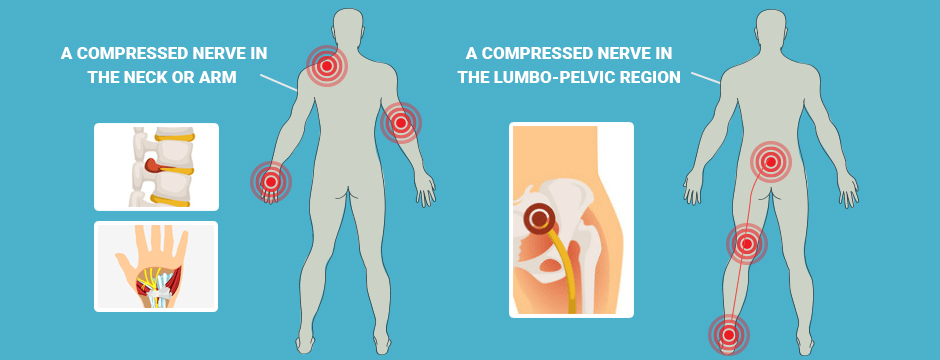Pinched Nerve Treatment
A pinched nerve can develop from one of several causes, including repetitive motion or holding a body part in one position for an extended length of time. Pain that travels down the neck and into the arm, or from the spine and down the leg, may cause you to become worried, especially if you have never experienced this type of pain before. Treatment of pinched nerves is vital, because symptoms and pain can worsen, limiting your activities and leading to more complex problems down the road.
A pinched nerve is actually an expression
It is a commonly-used term collectively describing multiple mechanisms of mechanical nerve dysfunctions, such as entrapment, compression, loss of gliding, and tension.
What is a Pinched Nerve?
Nerves originate at your brain and spinal cord and travel throughout every part of your body. Your brain sends messages via your spinal cord to tell your muscles when to fire, and how much force to produce. It also receives messages from proprioceptors in your joints and muscles about your body’s position in space, and alerts about pain from overuse or trauma.
A pinched nerve is a spinal nerve root that has been compressed. It can cause pain, a burning feeling or a sensation of pins and needles in your legs, arms, feet or hands. Depending on its location, a pinched nerve can impair movement and cause muscle weakness. Compression of a nerve root can usually be treated and resolved with conservative care, and rarely requires surgery.
How Exactly Nerves Are Getting Pinched
Nerves travel in anatomical tunnels. Most of the time, these tunnels are located inside the muscles and are composed of the fascia. However, when the nerves cross in between muscular heads or from one muscle to the other, the fascia corridors are usually thicker and more tortuous. This is exactly where nerve compression can occur.
Another anatomical location for the nerve entrapment is called fibro-osseous tunnels (FOT). FOT is a muscular or fascial connection to the bone in which space and gliding are limited. These are the frequent places of nerve entrapments.
Pinched Nerve Symptoms
A compressed nerve in the neck or arm can lead to pain, tingling, numbness and sensations of pins and needles in the fingers, hands, wrists and elbows. Repetitive motions during physical activity may worsen the condition.
A compressed nerve in the lumbo-pelvic region can cause pain and dysfunction in the lower extremities. If the large sciatic nerve is involved, you may experience pain, numbness and/or tingling anywhere from the low back and buttocks, down the legs and into your ankles and feet.
Pinched nerves may be involved in multiple conditions:
In most cases, accurate diagnosis and conservative treatment can resolve a pinched nerve in a relatively short span of time.
Causes of Pinched Nerves
In younger people, a pinched nerve often arises from physical activity or postural issues. Older adults may experience pinched nerves in response to degenerative diseases of the spine or joints.
Common causes of pinched nerves include:
- Poor posture when sitting and standing
- Awkward sleeping position
- Excessive use of electronic devices
- Too much sitting
- Poor lifting technique
- Being out of shape and overweight
- Degenerative conditions of the spine, like stenosis
- Narrowing of the vertebral foramina within the spinal column
- Herniated spinal discs
- Repetitive overuse from sports or exercise
- Inefficient motor patterns
- Deficiencies in walking or running gait
Pinched Nerve Treatment at NYDNRehab
The sports physical therapy and chiropractic team at NYDNRehab has on-site access to some of the most advanced rehab technologies and innovative therapies in the world. Our clinic is the only private clinic in the US to house a wide array of research-grade technology for assessment and rehab.
- Your healing journey begins with an accurate diagnosis, with the help of high resolution diagnostic ultrasound. Ultrasound imaging lets us view the nerves and structures of the body in real time, giving us an immediate and accurate diagnosis, so we can start your treatment plan right away.
- We use unique and innovative therapies to help realign your spine and take pressure off nerves. Your plan of care may include chiropractic treatment, acupuncture or dry needling, therapeutic massage, dynamic neuromuscular stabilization (DNS) and/or shock wave therapy.
- Our high-tech human performance lab lets us analyze your gait and biomechanics, to identify motor deficiencies that impact your nerves. Our assessment and treatment toolbox includes surface force plate technology, motion capture video, 3D gait analysis, Proteus Motion, Kineo Intelligent Load system, C.A.R.E.N. (computer assisted rehab environment) and much more.
- Your treatment will include corrective exercises and neuromuscular feedback to correct and resolve motor deficiencies and postural defects. You may be given a physical therapy exercise plan to do at home.
- One of the most effective ways to decompress the nerve is a nerve hydrodissection. A hydrodissection is a saline solution injection under ultrasound guidance, where a pressure created by the solution breaks up the adhesion between the nerve and the interface.
- You may be a candidate for TeleHealth services, where you meet with your therapist online, saving you from having to visit the clinic.
At NYDNRehab, we don’t just focus on pain management. We get to the source of pain through quantitative analysis, and correct motor deficiencies, muscular weaknesses and postural problems that put pressure on your nerves and keep you from doing the activities you enjoy.
Range of Available Unique Physical Therapy Treatments at Nydnrehab
About the Author
Dr. Lev Kalika is clinical director of NYDNRehab, located in Manhattan. Lev Kalika is the author of multiple medical publications and research, and an international expert in the field of rehabilitative sonography, ultrasound guided dry needling and sports medicine Dr. Kalika works with athletes, runners, dancers and mainstream clients to relieve pain, rehabilitate injuries, enhance performance and minimize the risk of injuries. His clinic features some of the most technologically advanced equipment in the world, rarely found in a private clinic.


























































